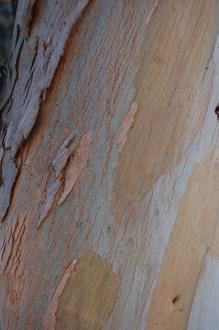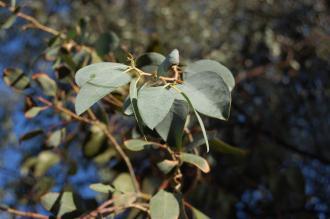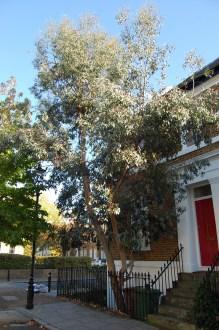
Eucalyptus gunnii bark (01/11/2011, London)
Position: Full Sun
Flowering period: Early summer
Soil: Well drained
Eventual Height: 35m
Eventual Spread: 12m
Hardiness: USDA Zones 7b – 11a
Family: Myrtaceae
Eucalyptus gunnii is a fast growing small to medium sized evergreen tree with a spreading growth habit. The bark of the tree sheds to leave a smooth, yellowish, patchy surface weathering to white – green or pink – gray. The gray green leaves of this plant are in two forms, juvenile and mature. The juvenile leaves are round and 3cm to 5cm across, the mature leaves are narrowly to broadly lanceolate and 10cm long. The hermaphrodite flowers of the tree are creamy white in color and are quite small in size. Their buds are capped.

Eucalyptus gunnii leaf (01/11/2011, London)
Eucalyptus gunnii, commonly known as Cider Gum or Gunnii, is native to Tasmania, occurring on the plains and slopes of the central plateaux to around 1000 metres, with isolated occurrences south of Hobart. E. gunnii is noted for exceptional cold tolerance and is commonly planted as an ornamental tree across the British Isles and some parts of western Europe. It produces a sweet sap, similar to maple syrup, this may be fermented to produce an alcoholic drink similar to cider.
The name Eucalyptus is derived from the Greek eu ‘good‘ and kalyptos ’covered’ referring to the calyx which forms a lid over the flowers when in bud. Gunni is named after Ronald Campell Gunn, the 19th century British botanist and legislator in Launceston, Tasmania.

Eucalyptus gunnii (01/11/2011, London)
The landscape architect may find Eucalyptus gunnii useful as a blue/ gray specimen tree. It may also be grown as a large shrub if pollarded or stooled on a regular basis. It is drought tolerant once established.
Ecologically, this plant is very attractive to bees. It is also noted for attracting other wildlife.
E. gunnii was awarded the prestigious Royal Horticultural Societies annual Award of Garden Merit in 1993.
E. gunnii will tolerate most soils although it prefers well drained soil. It does not grow well on sandy or chalky soils and will not tolerate wet soil conditions.
Maintenance: This tree requires little maintenance. It may be maintained as a shrub, with juvenile foliage by stooling or pollarding it in late winter.
Advertisement Eco World Content From Across The Internet.

